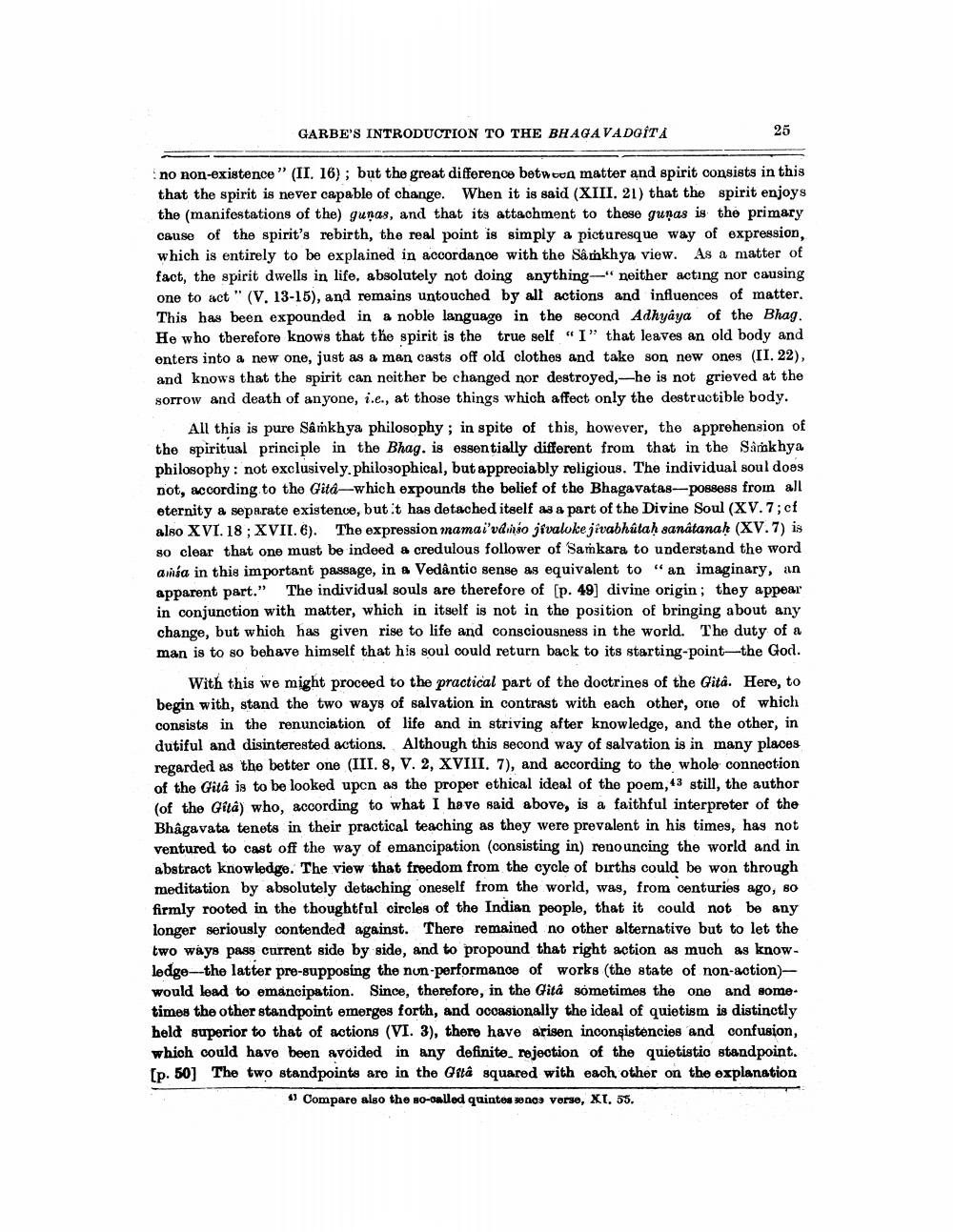________________
25
GARBE'S INTRODUCTION TO THE BHAGAVADGITA
no non-existence" (II. 16); but the great difference between matter and spirit consists in this that the spirit is never capable of change. When it is said (XIII. 21) that the spirit enjoys the (manifestations of the) gunas, and that its attachment to these gunas is the primary cause of the spirit's rebirth, the real point is simply a picturesque way of expression, which is entirely to be explained in accordance with the Sâmkhya view. As a matter of fact, the spirit dwells in life, absolutely not doing anything-" neither acting nor causing one to act" (V. 13-15), and remains untouched by all actions and influences of matter. This has been expounded in a noble language in the second Adhyaya of the Bhag. He who therefore knows that the spirit is the true self "I" that leaves an old body and enters into a new one, just as a man casts off old clothes and take son new ones (II. 22), and knows that the spirit can neither be changed nor destroyed, he is not grieved at the sorrow and death of anyone, i.e., at those things which affect only the destructible body.
All this is pure Sâmkhya philosophy; in spite of this, however, the apprehension of the spiritual principle in the Bhag. is essentially different from that in the Samkhya philosophy: not exclusively. philosophical, but appreciably religious. The individual soul does not, according to the Gita-which expounds the belief of the Bhagavatas-possess from all eternity a separate existence, but it has detached itself as a part of the Divine Soul (XV.7; cf also XVI. 18; XVII. 6). The expression mamai'vamo jivaloke jivabhûtaḥ sanâtanah (XV.7) is so clear that one must be indeed a credulous follower of Samkara to understand the word amia in this important passage, in a Vedantic sense as equivalent to "an imaginary, an apparent part." The individual souls are therefore of [p. 49] divine origin; they appear in conjunction with matter, which in itself is not in the position of bringing about any change, but which has given rise to life and consciousness in the world. The duty of a man is to so behave himself that his soul could return back to its starting-point-the God.
With this we might proceed to the practical part of the doctrines of the Gitâ. Here, to begin with, stand the two ways of salvation in contrast with each other, one of which consists in the renunciation of life and in striving after knowledge, and the other, in dutiful and disinterested actions. Although this second way of salvation is in many places regarded as the better one (III. 8, V. 2, XVIII. 7), and according to the whole connection of the Gitâ is to be looked upon as the proper ethical ideal of the poem, 43 still, the author (of the Gita) who, according to what I have said above, is a faithful interpreter of the Bhagavata tenets in their practical teaching as they were prevalent in his times, has not ventured to cast off the way of emancipation (consisting in) renouncing the world and in abstract knowledge. The view that freedom from the cycle of births could be won through meditation by absolutely detaching oneself from the world, was, from centuries ago, so firmly rooted in the thoughtful circles of the Indian people, that it could not be any longer seriously contended against. There remained no other alternative but to let the two ways pass current side by side, and to propound that right action as much as knowledge--the latter pre-supposing the non-performance of works (the state of non-action)would lead to emancipation. Since, therefore, in the Gitâ sometimes the one and sometimes the other standpoint emerges forth, and occasionally the ideal of quietism is distinctly held superior to that of actions (VI. 3), there have arisen inconsistencies and confusion, which could have been avoided in any definite. rejection of the quietistic standpoint. [p. 50] The two standpoints are in the Gita squared with each other on the explanation
43 Compare also the so-called quintessence verse, XI, 55.




